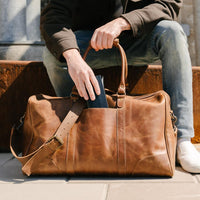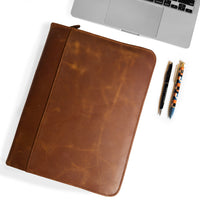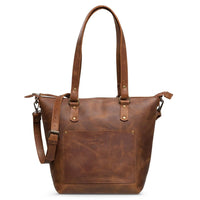Leather Grades
Full Grain
This is the most expensive classification for real leather goods. The outermost layer of animal skin is used due to the durability it provides. Full grain leather is left unfinished to allow the unique characteristics to flourish and natural shade to appear. Full grain leather is often difficult to come by, as the material is scarce due to limited accessibility. Since there’s a limited amount of the leather to work with and the toughness of it proves difficult to handle, users can expect to pay a higher price tag, which is justified in the value and quality presented in the product.
Top Grain
High-quality real leather at an affordable price, top grain goods deal with the skin just below the full grain. Imperfections are removed, and the skin is smoothed out. It loses the uniqueness of full grain leather but is still considered high quality and durable material for producing leather products.
Genuine
Genuine leather uses the softer skin below the surface. It’s cheaper and easy to manufacture but not as durable as the other leather grains. It essentially blends various pieces of low quality leather together to create a usable skin for composition of leather products.
Bonded
A low-quality real leather option that uses leather shavings to create products. While it’s still considered real leather, it’s often used for book covers and other products that aren’t usually worn or handled regularly. The leather scraps are ground up and glued together to make a single piece of hide.
Identification Techniques
Explicit Labelling
Manufacturers are proud of their real leather products and will insert labels that communicate that fact to potential customers. If it’s not explicitly stated that the product is made with real leather (with identification of the quality of leather, for example: Full-grain leather) then it’s safe to assume that it might be a manmade material. If you’re looking at older, used items, then there’s always a chance the tag fell off over time. It’s a good thing you can identify real leather through other means.
Surface Pores
Look for any imperfections or unique markers on the surface of the leather. As real leather is an animal product, pores and imperfections are to be expected. If the grain you’re looking at is uniform and even throughout, then it’s most likely a synthetic leather product. Real leather will also absorb moisture within a few seconds, while water will sit on top of manmade materials.
Creasing and Wrinkling
As real leather is the skin of an animal, it will wrinkle and crease both naturally and if you’re to press into it. Manmade leather will remain rigid and hold its shape.
Scent
Real leather bags or jackets will emit a natural, musty smell, as opposed to the plastic or chemical-like smell synthetic leather releases. To make sure you can understand the pure scent of real leather, go into a store that sells high quality real leather products and sniff around. Once you’re comfortable with the smell of real leather, identifying it from synthetic leather will be no problem.
Rough Edges
The edges of real leather products are rough and slightly uneven, the opposite of the perfect edges on fake leather goods. Real leather is composed of strands that naturally fray over time, whereas manmade leather edges are clean cut.
Pricing
Real leather products don’t come with a low price tag unless you’re buying it used and worn. Products that are 100% leather are expensive, there’s no way around that. Browse through the price ranges for real, semi-real and synthetic leather goods to understand the variations between them.
At Hides Canada, we’re an independently owned Canadian leather company that offers full grain leather products. We have a wide range of high-quality leather products including leather backpacks, gloves, men’s and women’s leather apparel and bags, and more. Based in Toronto, Ontario, shop our Niagara and Mississauga stores, or order online at https://hidescanada.com.










